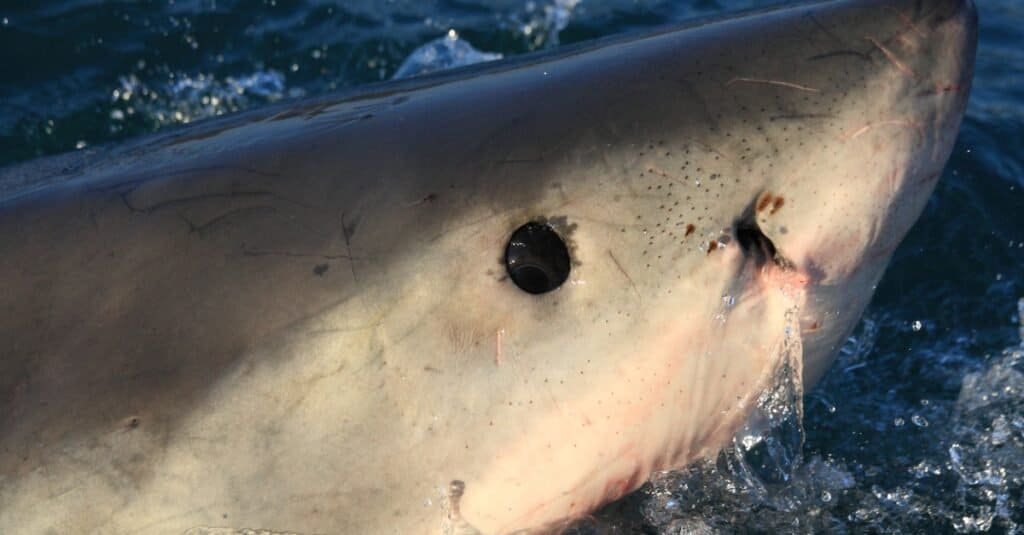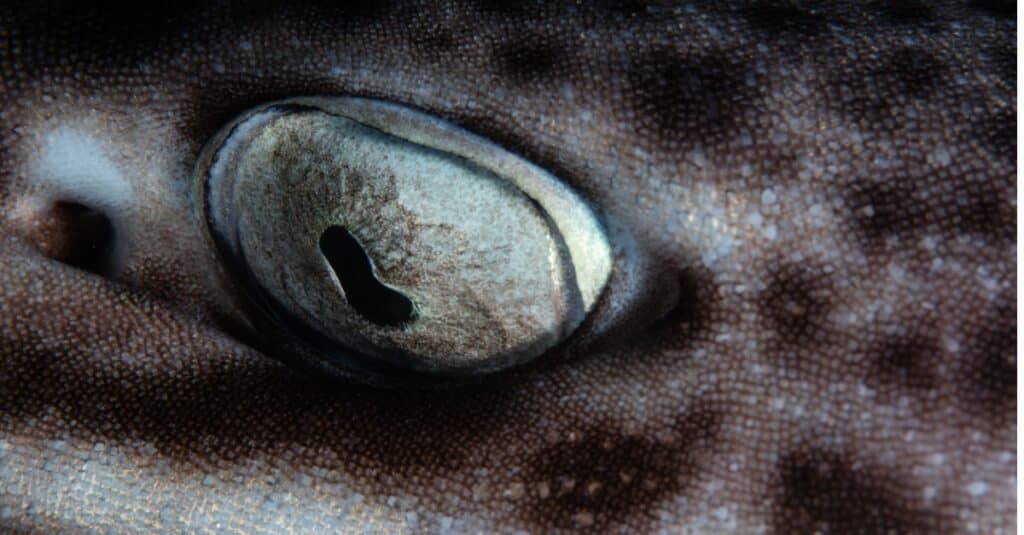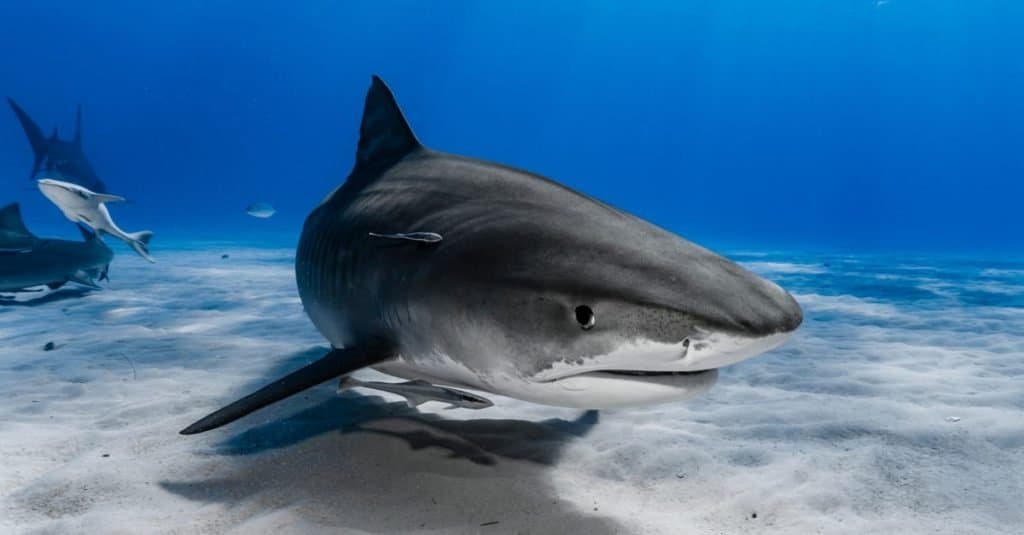You might have heard people say that sharks have black, expressionless eyes, and trying to decipher these unfathomable depths is something which scientists have been trying to do for a long time. However, new research is continually changing our perception of these fascinating animals and how their bodies work. When it comes to shark eyes, it has often been thought that they have poor eyesight. However, another interesting question about them is “are sharks color blind or not?”, and how this affects their ability to detect their prey. So, let’s dive in and discover the answer!
How Do Shark Eyes Work?

Sharks have a unique feature which helps them to see better in dark or murky water.
©iStock.com/Alessandro De Maddalena
Sharks eyes are one of the least understood aspects of these fierce predators. Although their eyes function in a similar way to our own, they actually have many sophisticated features which make them uniquely suited to their habitat and lifestyle.
For a start, sharks have all the same essential parts which are the same as our own eyes. This includes the pupil, iris, lens, retina, and cornea. However, sharks also have a particularly unique feature which helps them to see well in poor light conditions — called tapetum lucidum.
Many sharks live and hunt in dark and murky water. Therefore, anything which helps them to detect their prey better is incredibly useful. Tapetum lucidum is essentially a reflective layer which is located behind the retina. Light enters the eye and goes through the retina. It then hits the tapetum lucidum and is then reflected back onto the retina. This means that the light that entered the eye is available to the retina twice. This vastly improves the shark’s ability to see in murky water.
Many animals have the tapetum lucidum in their eyes — including cats, dogs, horses, and cows. Most of the animals with a tapetum lucidum are mammals, although a small number of reptiles have it too. However, primates (including us humans), pigs, kangaroos, and squirrels lack it completely.
Are Sharks Really Color Blind?

Most shark eyes lack cone cells, rendering them color blind.
©iStock.com/Velvetfish
Yes, evidence suggests that most species of sharks are color blind.
Sharks have several photoreceptor cells in their eyes which are called rods and cones. Rods are used to distinguish between light and dark, while cones are used to distinguish color. Rods are extremely sensitive to light. Along with the tapetum lucidum, they are one of the reasons that sharks are able to see well in dark or murky water. However, although sharks have many rods, they do not have many cones.
For a long time, there has been some dispute between scientists as to just how many cones sharks have and how much color they can see, owing largely to how little is truly known about shark eyes. However, a 2011 study has now proved that most species of sharks either completely lack or possess only one cone cell. The study was conducted on 17 species of sharks in Australia from several different family groups. It found that 10 of the species did not have any cone cells at all, while the remaining seven had only one type.
What Does a Lack of Cone Cells Mean for Sharks?
Cone cells are typically classified into three types — short, medium, and long wavelength. These types then determine which spectrum of color is able to be distinguished. In general terms, blue is short, green is medium, and red is long. The cone cells which were found in the seven species of sharks which possessed them were all long-wavelength sensitive cones.
The sharks without any cone cells are unable to distinguish any color at all, while those with only one type of cones are classed as being cone monochromats. Cone monochromancy essentially means that the shark is not able to see different hues.
There are approximately 400 different species of sharks worldwide, so it is difficult to make a conclusion as to whether every species of shark is color blind. However, as the study looked at sharks from more than just one family group, the evidence does suggest that most of them are unable to distinguish color. Instead, as they have many rod cells, sharks rely more heavily on their ability to distinguish between light and dark. As a result of this, objects with higher contrast colors are believed to be easier to for sharks to see.
How Well Can Sharks Actually See?

Sharks actually have good eyesight and can see objects up to 50 feet away.
©kaschibo/Shutterstock.com
You might now be wondering just how well sharks can actually see if most of them are color blind. However, the truth is, they can actually see pretty well, albeit only to a distance of approximately 50 feet.
One of the reasons that sharks have good eyesight is because they are able to change their field of vision. Sharks are able to see in both monocular and stereoscopic vision. Monocular vision allows them to see using the images from just one eye and improves the quality of the image, although it provides poor depth perception. However, stereoscopic vision provides a three-dimensional image and uses the images from both eyes. This type of vision gives the images depth, shape, and distance. It is the same type of vision that we use.
Do Sharks Have Blinds Spots?
Although sharks do have good eyesight, they also have two significant blind spots. Sharks eyes are located on either side of their head to give them a good field of vision. Despite this, they are unable to see anything which is just behind the top of their head or anything which is right in front of their snout. The location of this second blind spot might seem surprising, given that it means that sharks can’t see anything right in front of their snout in the last moments before they attack their prey. However, there are some species of sharks which are essentially completely blind while they are attacking for a different reason.
Shark’s eyes are actually a very vulnerable spot on them as they lack eyelids. This means they can easily be injured while the shark is hunting. To avoid this situation, some species have a nictitating membrane which is transparent and comes down to protect the eyes. However, not all sharks have a nictitating membrane. Instead, these sharks simply roll their eyes backwards in those vulnerable moments to protect them, even though it leaves them completely unable to see. So, if you’ve ever heard stories about how sharks show the whites of their eyes as they are attacking, the reason is actually simply that they are protecting themselves.
The photo featured at the top of this post is © Havoc/Shutterstock.com
Thank you for reading! Have some feedback for us? Contact the AZ Animals editorial team.






